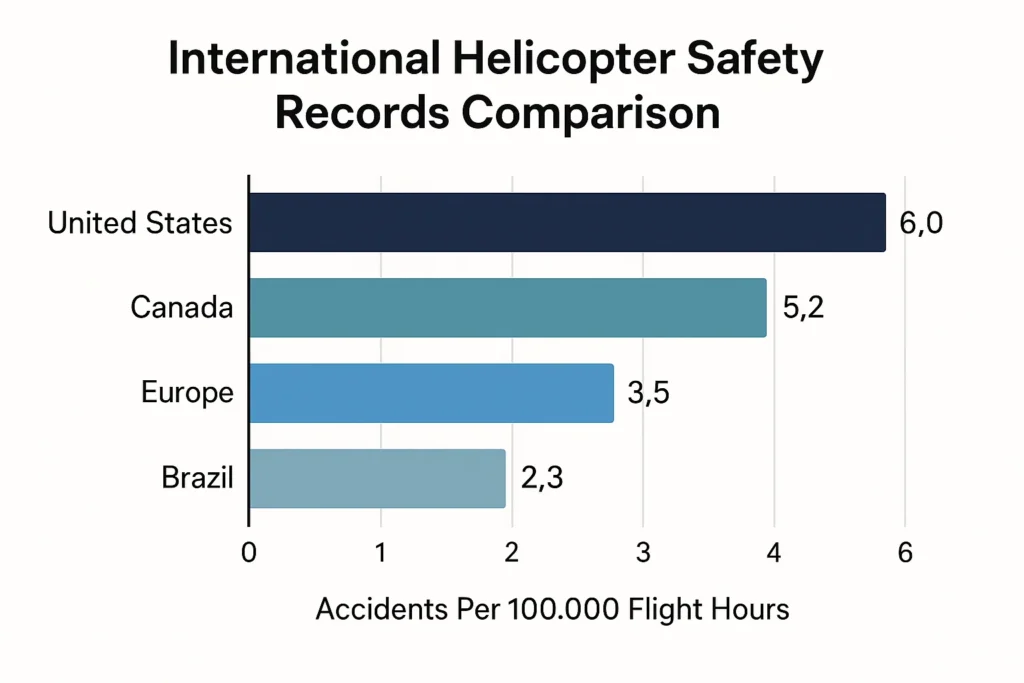🧭 Introduction: Why Helicopter Safety Matters
Helicopters are vital for emergency rescue, tourism, military, and corporate use — but are they safe?
Globally, helicopter safety records vary widely depending on airspace regulation, training, technology, and terrain. In this comparison report, DreamSafar.in explores how countries like the USA, India, Australia, Russia, and Brazil rank in helicopter safety and what factors influence these differences.
🌐 Key Metrics for Helicopter Safety
| Metric | Description |
|---|---|
| Accident Rate | Accidents per 100,000 flight hours |
| Fatality Rate | Fatal crashes per year |
| Regulatory Oversight | Strength of aviation authority |
| Terrain & Weather Risk | Exposure to challenging environments |
| Pilot Training Standards | National qualification requirements |
| Maintenance Infrastructure | Access to certified repair and upgrade centers |
🌍 Global Comparison of Helicopter Safety Records
| Country | Accident Rate (per 100k hrs) | Fatalities per Year | Oversight Agency |
|---|---|---|---|
| 🇺🇸 USA | 3.9 | ~120 | FAA (Federal Aviation) |
| 🇦🇺 Australia | 3.2 | ~20 | CASA |
| 🇮🇳 India | 6.1 | ~25 | DGCA |
| 🇷🇺 Russia | 7.5 | ~45 | Federal Air Transport |
| 🇧🇷 Brazil | 5.8 | ~30 | ANAC |
| 🇨🇦 Canada | 2.8 | ~15 | Transport Canada |
🔍 Note: Numbers are estimates based on ICAO and national accident data between 2019–2024.
🛫 Countries with Best Safety Records
🇨🇦 Canada
-
Strong infrastructure for cold-weather operations
-
Low accident rate despite vast wilderness flying
-
Mandatory crew resource management (CRM) training
🇦🇺 Australia
-
Leads in aerial firefighting safety
-
Uses real-time flight tracking during bushfires
-
Strict pilot fatigue and maintenance rules
🇺🇸 USA
-
World’s largest civilian helicopter fleet
-
Home to NTSB investigations and robust reporting systems
-
FAA mandates regular checkrides and simulator training
⚠️ Higher-Risk Countries
🇮🇳 India
-
Challenging terrain in Himalayas and Northeast
-
Older helicopters in civil sectors
-
Growing efforts via DGCA on air ambulance safety
🇷🇺 Russia
-
Vast, remote terrain leads to poor ground response
-
Many military-grade helicopters used commercially
-
Harsh weather in Siberia complicates safety ops
🇧🇷 Brazil
-
High urban use (e.g., São Paulo helicopter taxi)
-
Frequent weather-related visibility issues
-
Traffic control strain in major metros
🧪 Factors That Improve Safety
-
Black box & cockpit voice recorder (CVR) usage
-
Helicopter Health Monitoring Systems (HUMS)
-
Pilot rest and duty hour restrictions
-
Weather radar and GPS autotracking
-
Use of night-vision goggles (NVG) for SAR missions
🛠️ Countries investing in modern aircraft, pilot training, and transparent incident reporting consistently rank safer.
🔗 Useful Links – DreamSafar.in
🌐 External Resources
❓ FAQ: Helicopter Safety Records
❓ Are helicopters more dangerous than airplanes?
Statistically, helicopters have higher accident rates per flight hour but operate in riskier conditions like rescues, mountain flying, and landing in tight zones.
❓ Which country is safest for helicopter flying?
Canada and Australia consistently have low accident rates, strong training programs, and modern fleets.
❓ What makes helicopter accidents more likely?
Common causes include pilot error, mechanical failure, bad weather, and low visibility operations.
❓ How can passengers ensure safety?
-
Fly with licensed operators
-
Check maintenance certifications
-
Ask about weather contingency protocols
🏁 Final Thoughts
Helicopters offer freedom and agility — but also demand stringent safety standards. Countries with strong oversight and transparent data tend to have better helicopter safety records, protecting both passengers and crew.
For more global aviation insights and rotorcraft trends, follow DreamSafar.in.


